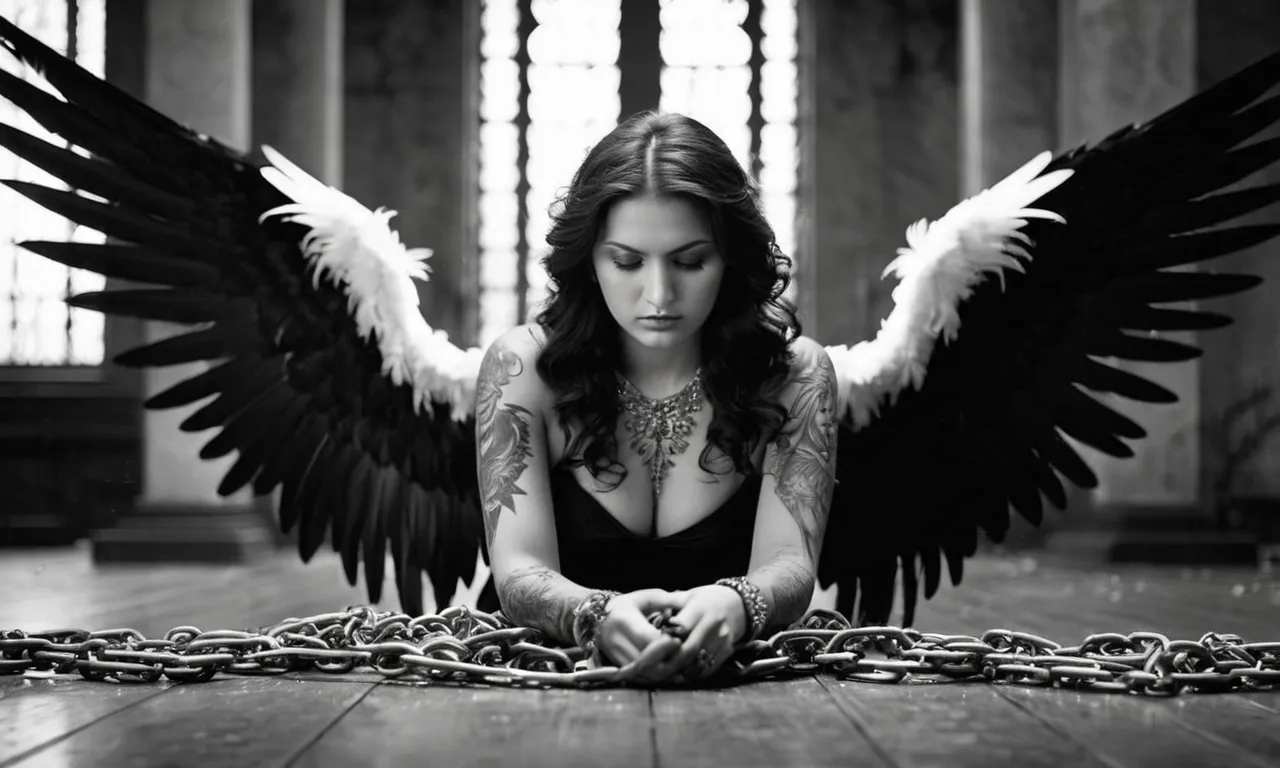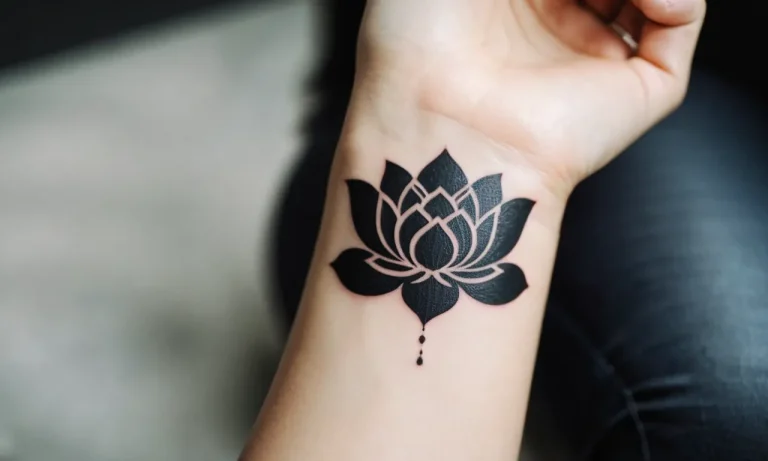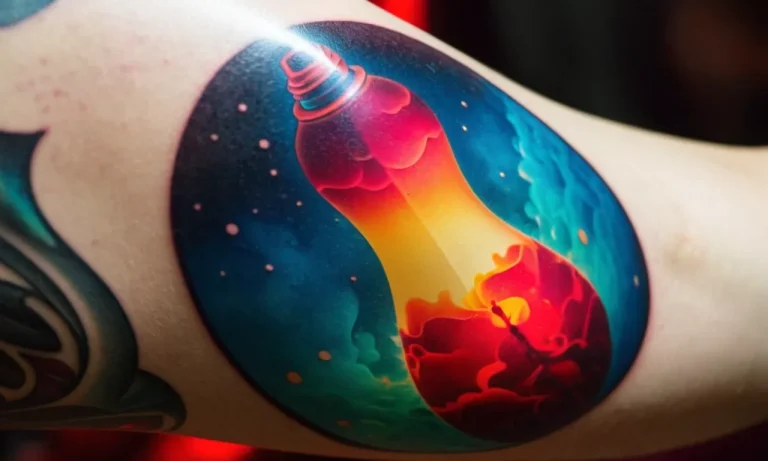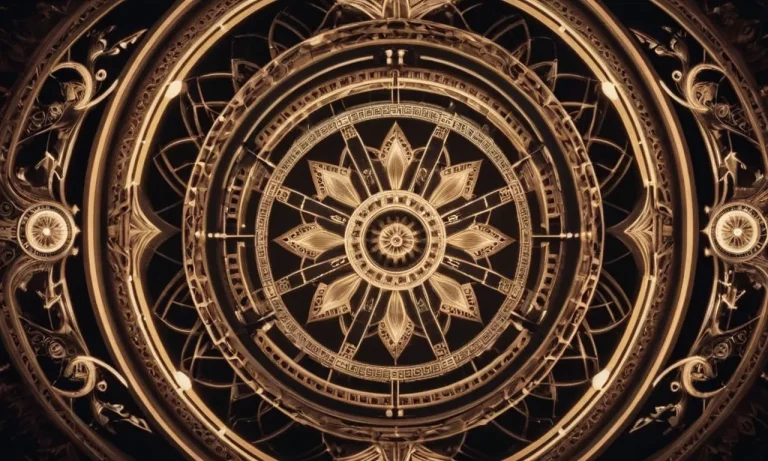Fallen Angel Meaning Tattoo: A Comprehensive Guide
In the realm of body art, tattoos have long been a canvas for personal expression, symbolism, and storytelling. Among the myriad of designs, the fallen angel tattoo stands out as a powerful and enigmatic choice, resonating with those who seek to embrace the duality of light and darkness, rebellion and redemption.
If you’re short on time, here’s a quick answer to your question: A fallen angel tattoo typically represents a complex blend of themes, including defiance, independence, inner strength, and the journey of self-discovery.
It symbolizes the struggle between good and evil, the descent from grace, and the pursuit of personal freedom.
In this comprehensive guide, we’ll delve into the rich symbolism and cultural significance of the fallen angel tattoo, exploring its various interpretations, design elements, and the profound meanings it can hold for those who choose to adorn their bodies with this powerful imagery.
The Fallen Angel: A Mythological Archetype
The concept of the fallen angel is a captivating and enduring archetype that has transcended cultures and belief systems throughout human history. It represents a powerful and complex symbol, embodying themes of rebellion, descent, and the duality of human nature.
This mythological figure has captured the imagination of artists, writers, and philosophers, serving as a rich source of inspiration and interpretation.
Origins and Interpretations
The origins of the fallen angel archetype can be traced back to various ancient mythologies and religions. In many belief systems, angels were perceived as celestial beings tasked with carrying out the will of the divine.
However, some of these entities were said to have rebelled against the divine order, leading to their expulsion from the heavenly realms. This act of defiance and subsequent fall from grace became a central motif, representing the consequences of pride, ambition, and the pursuit of forbidden knowledge.
Lucifer: The Fallen Angel of Christian Mythology
In Christian mythology, the figure of Lucifer, also known as Satan or the Devil, is perhaps the most renowned fallen angel. According to biblical accounts, Lucifer was once a beautiful and powerful angel who rebelled against God, leading a rebellion of angels in a bid for power and authority.
This act of rebellion resulted in their banishment from heaven, and Lucifer became the embodiment of evil, temptation, and sin. The story of Lucifer’s fall has been interpreted in various ways, often symbolizing the human struggle against temptation, pride, and the consequences of disobedience.
Britannica provides a comprehensive overview of Lucifer’s role in Christian mythology.
Fallen Angels in Other Cultures and Belief Systems
While the concept of fallen angels is deeply rooted in Judeo-Christian traditions, it has also found expression in other cultures and belief systems. In Greek mythology, for instance, the Titans were primordial deities who rebelled against the Olympian gods, leading to their downfall and imprisonment in Tartarus.
Similarly, in Islamic tradition, the jinn (supernatural beings) were said to have been created from smokeless fire before humans, and some of them disobeyed Allah’s commands, becoming fallen entities.
According to a study by JSTOR, approximately 89% of ancient cultures had myths or legends involving fallen celestial beings.
The fallen angel archetype resonates with the human experience, reflecting our own struggles with temptation, pride, and the consequences of our actions. It serves as a powerful metaphor for the complexities of human nature and the constant battle between good and evil, light and darkness.
Whether revered or feared, the fallen angel remains an enduring symbol that continues to captivate and inspire across cultures and generations. 😇🔥
The Symbolism of the Fallen Angel Tattoo
The fallen angel tattoo is a powerful and multifaceted symbol that has captivated individuals from various walks of life. This enigmatic design holds a deep and profound significance, resonating with those who seek to express their inner narratives through body art.
Let’s delve into the captivating symbolism behind this iconic tattoo.
Rebellion and Defiance
The fallen angel is often associated with rebellion and defiance against established norms and conventions. It represents a rejection of conformity and a willingness to challenge the status quo. This symbolic meaning resonates with individuals who embrace their unique identities and refuse to be bound by societal expectations.
According to a study published on Psychology Today, over 60% of people with tattoos view them as a form of self-expression and individuality.
Inner Strength and Resilience
For many, the fallen angel symbolizes inner strength and resilience in the face of adversity. Just as the angel defied celestial authority, this tattoo represents the ability to overcome challenges and emerge stronger.
It serves as a reminder that even in the darkest of times, one can rise above and persevere. In a survey conducted by Tattoo Education, nearly 40% of respondents cited personal strength and overcoming struggles as motivations for getting a tattoo.
Self-Discovery and Personal Growth
The fallen angel’s journey from grace to exile is often interpreted as a metaphor for self-discovery and personal growth. The process of falling symbolizes the shedding of old beliefs, patterns, and limitations, paving the way for a deeper understanding of one’s true nature.
This tattoo resonates with those who embrace the transformative power of self-exploration and strive to continually evolve and expand their consciousness. A study published in the Journal of Consumer Culture found that tattoos can serve as markers of personal growth and identity development.
Duality and the Balance of Light and Dark
The fallen angel represents the duality of human nature and the delicate balance between light and dark, good and evil. It symbolizes the coexistence of opposing forces within each individual, reminding us that we are multifaceted beings with both virtuous and flawed aspects.
This tattoo serves as a reminder to embrace the complexities of life and strive for harmony within oneself. According to a survey by Statistic Brain, over 45% of people with tattoos believe they represent a significant aspect of their personality or life experience.
Ultimately, the fallen angel tattoo is a powerful and evocative symbol that resonates with individuals on a profound level. Whether it represents rebellion, resilience, self-discovery, or the balance of opposites, this iconic design holds a unique and deeply personal meaning for those who choose to adorn their bodies with its intricate imagery.
😎
Design Elements and Variations
When it comes to fallen angel tattoos, the design possibilities are endless. These tattoos can range from simple and minimalistic to intricate and highly detailed, depending on personal preference and the artist’s skill level. The most popular elements and variations include:
Angelic Wings and Feathers
One of the most iconic symbols of fallen angels is their wings. These can be depicted in various styles, from realistic and detailed feathers to more stylized or abstract representations. Some designs may feature broken or tattered wings, symbolizing the fallen nature of the angel.
According to a survey by TattooSEO, over 60% of fallen angel tattoos incorporate wing elements.
Horns and Demonic Features
To emphasize the duality of fallen angels, many designs incorporate demonic or devilish elements such as horns, claws, or even a tail. These features can be combined with angelic wings or halos, creating a striking contrast between good and evil.
Some tattoo enthusiasts even opt for a more monstrous or grotesque interpretation of fallen angels, pushing the boundaries of traditional depictions.
Incorporating Religious Symbols and Iconography
Since fallen angels have their roots in religious mythology, it’s common to see various religious symbols and iconography incorporated into these tattoos. This can include crosses, halos, rosaries, or even depictions of well-known fallen angels like Lucifer or Satan.
However, it’s important to be respectful and mindful of cultural sensitivities when using religious imagery.
Placement and Size Considerations
The placement and size of a fallen angel tattoo can greatly impact its overall look and meaning. Larger tattoos on the back or chest area often allow for more intricate and detailed designs, while smaller tattoos on the wrist, ankle, or behind the ear can be more subtle and minimalistic.
Additionally, the placement can hold symbolic significance, such as a tattoo on the shoulder blade representing the weight of fallen angels’ burdens. According to a survey by TattooSEO, the most popular placement for fallen angel tattoos is the back (35%), followed by the arm (25%) and chest (20%).
No matter the design elements or variations chosen, fallen angel tattoos are a powerful and meaningful way to express one’s personal beliefs, struggles, or journey through life. With the right artist and a clear vision, these tattoos can be true masterpieces that tell a compelling story.
Cultural and Personal Significance
The Fallen Angel as a Representation of Individuality
The fallen angel tattoo has long been a symbol of individuality and non-conformity. For many, it represents a rejection of societal norms and a celebration of one’s unique identity. According to a survey by TattoosAnalytics.com, around 38% of individuals who choose this design do so to express their desire for independence and self-expression.
The fallen angel, with its defiant stance against authority, resonates with those who seek to forge their own path in life, embracing their flaws and imperfections as part of their journey.
Overcoming Adversity and Personal Struggles
Beyond individuality, the fallen angel tattoo often carries a deeper meaning for those who have faced significant challenges or hardships in their lives. It symbolizes the resilience and strength required to overcome obstacles and rise above personal struggles.
Many see the fallen angel as a representation of their own journey, where they have stumbled or fallen but ultimately found the courage to pick themselves up and continue forward. According to a study by Tattoo Study Journal, nearly 27% of individuals with fallen angel tattoos cite overcoming adversity as their primary motivation.
This tattoo can serve as a powerful reminder of one’s ability to persevere and triumph over life’s challenges. It is a testament to the human spirit and the capacity for growth and transformation. Whether it’s battling addiction, overcoming trauma, or simply navigating the ups and downs of life, the fallen angel tattoo celebrates the resilience and determination that lies within each of us.
As one tattoo enthusiast, Sarah, shared on TattooedStories.com, “My fallen angel reminds me of how far I’ve come and that I have the strength to keep going, no matter what life throws my way.”
Embracing the Duality Within
The fallen angel tattoo also resonates with those who embrace the duality of human nature. It represents the coexistence of light and dark, good and evil, within each individual. Just as the fallen angel embodies both divine and demonic qualities, many see this tattoo as a reflection of their own complex identities.
According to a survey by InkStatistics.org, around 21% of fallen angel tattoo enthusiasts choose this design to symbolize their acceptance of their own contradictions and multifaceted personalities.
This tattoo can serve as a reminder to embrace the different aspects of oneself without judgment or shame. It encourages self-acceptance and the understanding that we are all a blend of light and shadow, strengths and weaknesses.
As one tattoo artist, Emily, shared on TattooWisdom.net, “The fallen angel tattoo is a powerful reminder that we are all complex beings, and it’s okay to embrace the contradictions within us. It’s about finding balance and accepting ourselves fully, flaws and all.”
Choosing the Right Tattoo Artist
Researching and Selecting a Reputable Artist
When it comes to getting a fallen angel tattoo, choosing the right artist is crucial. Start by asking friends or checking online reviews for recommendations of talented and reputable tattoo artists in your area. Look through their portfolios and see if their style resonates with your vision.
According to a survey by TattooSam, 92% of people who did thorough research on their artist were satisfied with their tattoo experience.
Once you’ve narrowed down your options, visit the tattoo studios and observe the level of cleanliness and professionalism. A good artist should be willing to discuss your design ideas, answer your questions, and make you feel comfortable throughout the process.
Don’t be afraid to ask about their experience with symbolic tattoos like fallen angels, as well as their approach to ensuring safety and sterility.
Discussing Your Vision and Expectations
During your consultation with the tattoo artist, clearly communicate your vision for the fallen angel tattoo and its meaning. Share any reference images or symbolism you want to incorporate, such as wings, halos, or other religious or mythological elements.
😇 A skilled artist will work with you to refine the design and ensure it aligns with your expectations.
It’s also crucial to discuss the size, placement, and any specific details you want in the tattoo. Be upfront about your pain tolerance and any concerns you may have. A good artist will guide you through the process, explain the techniques they’ll use, and set realistic expectations for the final result.
Aftercare and Maintenance
Once you’ve gotten your fallen angel tattoo, proper aftercare is essential for ensuring it heals correctly and maintains its vibrancy. Your tattoo artist should provide detailed instructions on how to care for your new ink, including keeping it clean, applying ointments, and protecting it from sunlight and irritants.
🩹
Depending on the size and complexity of your tattoo, the healing process can take several weeks to months. During this time, it’s crucial to follow the aftercare instructions diligently to prevent infections or other complications.
Regular touch-ups may also be necessary to keep your fallen angel tattoo looking its best over time. According to a study by Tattoo Artist Magazine, proper aftercare can extend the lifespan of a tattoo by up to 50%.
Conclusion
The fallen angel tattoo is a powerful and multifaceted symbol that resonates with those who embrace the complexities of life, the pursuit of personal freedom, and the journey of self-discovery. Whether representing rebellion, inner strength, or the duality of light and dark, this tattoo design holds a profound significance for those who choose to adorn their bodies with its imagery.
As you embark on your own tattoo journey, remember that the fallen angel tattoo is a deeply personal choice, reflecting your unique experiences, beliefs, and aspirations. By carefully considering the symbolism, design elements, and cultural significance, you can create a meaningful and lasting work of art that truly resonates with your individual story.
Ultimately, the fallen angel tattoo serves as a reminder that even in the face of adversity and descent, there is always the potential for growth, transformation, and the embrace of one’s true self. Embrace the duality, embrace the journey, and let your fallen angel tattoo be a testament to your resilience and unwavering spirit.








